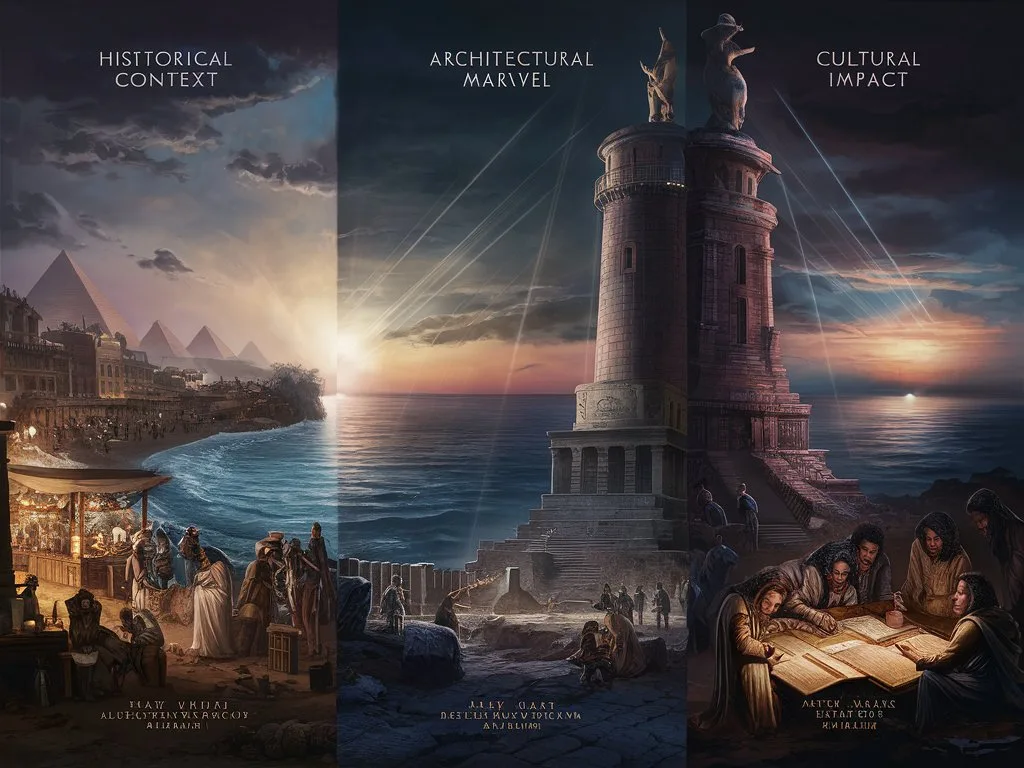Introduction to the Lighthouse of Alexandria

A. Historical Context
The Lighthouse of Alexandria, also known as the Pharos of Alexandria, is a remarkable construction that once served as a pivotal landmark for sailors navigating the treacherous waters of the Mediterranean. Built on the small island of Pharos, it was erected to guide vessels into the busy harbor of Alexandria, a city founded by Alexander the Great in 331 BC. This ancient metropolis became a beacon of culture, knowledge, and trade, featuring the largest library of its time. The lighthouse not only prevented dangerous shipwrecks but also exemplified the remarkable innovation of ancient engineering.
B. Architectural Marvel
Designed by the skilled Greek architect Sostratus of Cnidus, the Lighthouse of Alexandria was a staggering 100 meters high, establishing it as one of the tallest structures of the ancient world. Constructed from massive blocks of limestone and marble, it displayed a distinct three-tier structure: a square base, an octagonal midsection, and a circular top, potentially featuring a statue of either Zeus or Poseidon. Today, the engineering and beauty of this ancient wonder captivate modern audiences, reminding us of humanity’s creative spirit.
C. Cultural Impact
The Lighthouse of Alexandria has transcended time, inspiring artists, writers, and scholars across generations. Its grandeur is referenced in the work of various poets and historians, reinforcing its status as a central cultural landmark of ancient civilization. Even today, modern discussions about lighthouses often reference the ingenious design and navigational significance of the Pharos, showcasing its enduring impact on maritime history.
Astounding Facts About the Lighthouse

A. The Height of the Lighthouse
The original height of the Lighthouse of Alexandria is estimated to fall between 100 and 130 meters, far surpassing most buildings of its era. Its towering figure served as a landmark visible from 30 kilometers away, helping sailors find their way to safety and anchoring their vessels in the bustling trade routes that characterized Alexandria’s economy. Unlike today’s modern lighthouses, which generally range from 30 to 50 meters in height, the Pharos impresses with its monumental scale.
B. Engineering Techniques Used
Ancient Greeks employed remarkable engineering techniques to construct the Lighthouse of Alexandria. They utilized sophisticated methods, including ramps and levers, to maneuver heavy stones into place. This innovative approach highlighted the advanced construction techniques of the time, utilizing counterweights to lift massive blocks more effectively. Additionally, mirrors were strategically positioned to amplify the lighthouse’s light, extending its visibility across turbulent seas, a dazzling innovation unmatched by other structures.
C. The Lighthouse’s Light Source
To illuminate the Pharos, Greek engineers devised a unique system that involved burning wood or oil, complemented by polished bronze mirrors. This clever setup allowed for the focus and direction of light to guide sailors safely back to shore. As a pioneering structure in maritime history, the Lighthouse of Alexandria played a crucial role in the evolution of lighthouse design, showcasing the importance of effective navigation.
The Lighthouse in Historical Accounts

A. Early Descriptions
Renowned historians like Strabo and Pliny the Elder were among the earliest to describe the lighthouse, offering intricate details regarding its structure and function. Depictions can be found across various artistic mediums, providing glimpses of how the lighthouse was viewed by ancient peoples. Alongside artifacts and historical writings, these sources contribute to an understanding of the awe it inspired.
B. The Lighthouse Through the Ages
Over the centuries, the Lighthouse of Alexandria underwent modifications to accommodate changing technological, environmental, and cultural needs. The lighthouse-maintained relevance for civilizations such as the Romans and Muslim merchants, who utilized it for navigation. However, the structure faced challenges, succumbing to natural disasters, notably earthquakes in 956, 1303, and 1323, which eventually led to its demise.
C. Archaeological Discoveries
Continued archaeological excavations at the site of the former lighthouse offer tantalizing insights into its construction and significance. Remnants of stonework and underwater ruins reveal the complexities behind the once-grand structure, contributing to our knowledge of ancient maritime history and architectural ingenuity.
Myths and Legends Surrounding the Lighthouse

A. The Mythical Origins
Various myths attribute divine inspiration to the architect Sostratus, believed to have sought guidance during the lighthouse’s construction. These stories elevate the Pharos from a mere architectural wonder to a protective symbol for the city of Alexandria, enriching its narrative.
B. Folklore and Anecdotes
Local legends abound, recounting miraculous rescues of sailors caught in tumultuous storms. Tales suggest that the lighthouse served as a guardian spirit, overseeing ship voyages across the Mediterranean. Each anecdote contributes depth to the legacy of the lighthouse, blending history and myth seamlessly.
C. The Legacy of Myths Today
These age-old stories continue to resonate, influencing modern narratives in literature and film. The Lighthouse of Alexandria remains a potent symbol, inviting visitors and tourists to delve deeper into its fascinating history and mythology.
The Impact of the Lighthouse on Navigation and Trade

A. A Beacon for Ship Navigation
The Lighthouse of Alexandria served as an invaluable navigational aid, significantly reducing the risk of shipwrecks and enhancing maritime travel across the Mediterranean. It provided a critical point of reference, helping shape shipping routes and improving the efficiency of maritime logistics.
B. Economic Significance
The port of Alexandria flourished in part due to the lighthouse, which played a central role in regional commerce. By guiding traders safely to shore, it facilitated the influx of goods and services that bolstered the ancient economic landscape, leading to the formulation of maritime laws focusing on navigation.
C. Modern Influence on Lighthouses
The legacy of the Lighthouse of Alexandria still echoes in contemporary lighthouse designs and engineering strategies. Many present-day lighthouses carry principles originated from the Pharos, utilizing innovative lighting techniques and structural concepts that continue to guide naval activities.
Modern Interpretation and Symbolism of the Lighthouse

A. The Lighthouse as a Cultural Icon
Even today, the Lighthouse of Alexandria serves as a cultural emblem representing hope and guidance across various societies. It exemplifies maritime safety and international navigation rights, maintaining an important place in discussions about territorial waters.
B. Restoration and Preservation Efforts
Preservation of historical sites like the Lighthouse of Alexandria presents numerous challenges. Collaborative efforts among historians, archaeologists, and local governments are underway to honor the lighthouse’s legacy and ensure its story continues for future generations.
C. Educational Insights
The lighthouse’s historical significance also provides valuable educational opportunities. It serves as a teaching tool in maritime studies, engineering, and history, inspiring learners to appreciate the ancient civilization’s innovative spirit.
Conclusion

The Lighthouse of Alexandria remains an extraordinary testament to human ingenuity and the spirit of exploration. Its story is rich with inspiration and historical significance, urging us to uncover the mysteries of our shared past. Discover the captivating tales of history and let the light of Alexandria illuminate your journey into the ancient world!
FAQ
1. What was the Lighthouse of Alexandria?
The Lighthouse of Alexandria, also known as the Pharos of Alexandria, was one of the Seven of the Ancient World. It was a tall built on the small island of Pharos in Egypt to guide sailors safely into the busy harbor of Alexandria.
2. When was the Lighthouse of Alexandria built?
Construction of the Lighthouse began around 280 BC and was completed around 247 BC during the reign of Ptolemy II.
3. How tall was the Lighthouse of Alexandria?
The Lighthouse is believed to have been about 100 meters (approximately 330 feet) tall, making it one of the tallest structures of the ancient world.
4. What materials were used to build the Lighthouse of Alexandria?
The Lighthouse was primarily constructed using large blocks of light-colored stone, likely limestone and granite. Its strong foundation helped it withstand the elements.
5. How did the Lighthouse of Alexandria work?
The Lighthouse used a combination of an open flame and mirrors to reflect light and guide ships at night. During the day, a large fire would signal to sailors, and at night, the flames provided illumination.
6. What happened to the Lighthouse of Alexandria?
The Lighthouse suffered several earthquakes between the 3rd and 14th centuries, which led to its gradual destruction. By the end of the 15th century, it had largely collapsed and ceased to function.
7. Are there any remains of the Lighthouse of Alexandria today?
While the original Lighthouse no longer exists, some underwater archaeological remains can be found near the shores of Alexandria. These remnants give insights into the structure’s design.
8. Why is the Lighthouse of Alexandria significant?
The Lighthouse is significant not only for its architectural innovation but also for its historical role as a beacon for navigation. It symbolizes the advancements of ancient engineering and remains a subject of fascination in historical studies.
9. Did the Lighthouse of Alexandria influence modern lighthouses?
Yes, the design and structure of the Lighthouse of Alexandria have inspired the construction of many modern lighthouses, particularly in terms of height and the use of light to guide ships.
10. Are there any artworks or literature describing the Lighthouse of Alexandria?
Yes, many ancient historians and authors, including Strabo and Philo of Byzantium, wrote about the Lighthouse. Additionally, it has been depicted in various artworks throughout history, showcasing its grandeur and significance.

I don’t think the title of your article matches the content lol. Just kidding, mainly because I had some doubts after reading the article.
Your point of view caught my eye and was very interesting. Thanks. I have a question for you.
Can you be more specific about the content of your article? After reading it, I still have some doubts. Hope you can help me.